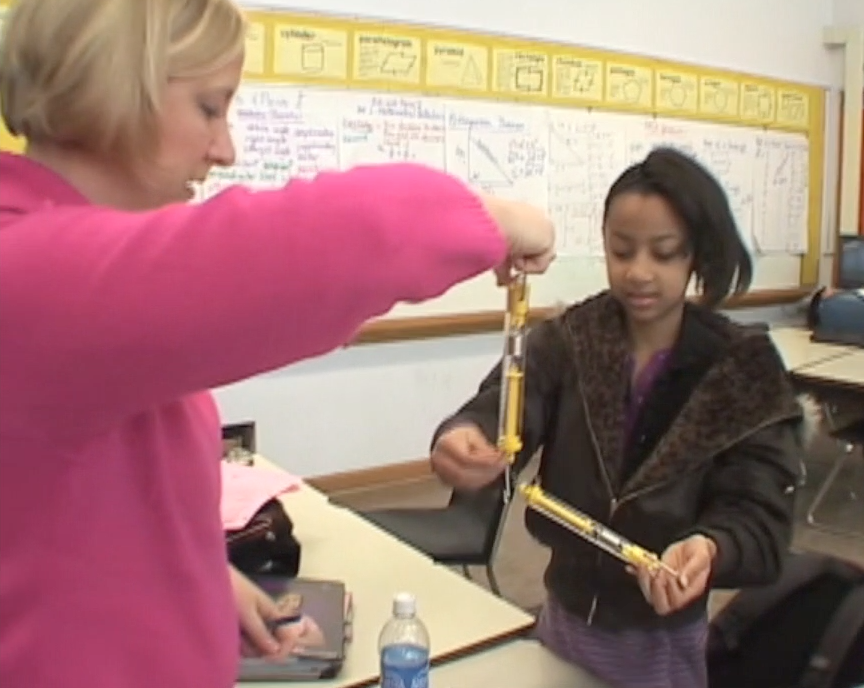
These videos are part of a Legacy Series, meaning that they were produced earlier than the other case studies you see on this website. These have been so popular with our viewers that we’ve included them here.
Participants in this video sequence are part of a comprehensive long-term educational program serving promising students of color. Most students in the program are the first in their family to go on to college.
This unit for 6th graders focuses on force and motion. The teacher, Melissa, uses sense-making discourse throughout the unit to help students develop a deep understanding of complex events like how a roller-blader starts, stops, and maneuvers. Melissa attends to everyday language and experiences of her students, and how these can be used as resources to develop scientific ideas. She combines a wealth of model building experiences with infusions of science ideas that can help students to talk about how unobservable events and processes influence what can been seen.
Pre-unit interview
Melissa describes the challenges of teaching for deep understanding. She talks through with the interviewer how she is trying to understand the science herself in new ways before teaching the unit.
It is important before watching these videos that you read the Discourse Primer on this website. You will see examples of re-voicing, pressing, marking, academic language, probing, etc.
Day 1 Eliciting students’ ideas about forces
The purpose of this activity is to have students collect some qualitative data (how it feels) to slide a block across different surfaces when the block is lighter & heavier. As students collect their data during the activity, Melissa is interested in hearing: 1) what they notice/pay attention to, 2) how they use their own everyday language to describe forces & motion.
Summary of Episodes:
1. Small groups slide a wooden block along a few carpet squares & smooth table to compare what sliding “feels” like on their pulling hand.
2. Small groups slide a wooden block + a heavy brick along surfaces to contrast this with the previous experience.
The purpose of this activity is to have students collect some qualitative data (how it feels) to slide a block across different surfaces when the block is lighter & heavier. As students collect their data during the activity, Melissa is interested in hearing: 1) what they notice/pay attention to, 2) how they use their own everyday language to describe forces & motion.
Interview after first day
Here Melissa responds to the question: What did we hear students saying? Using specific discourse moves she has made visible a range of partial understandings, everyday experiences, and language that students are using as resources to make sense of force and motion. This informs how she will adapt upcoming lessons.
Day 2 Generating an initial theory
Summary of Episodes:
1. Instructions for upcoming homework assignment – concept map linking key ideas about the sliding block which then serves as a pre-writing scaffold to help students write a letter to their literacy teacher explaining why the block slides differently on different surface & differently when it is different weights.
2. Small group work generating an initial theory of motion – creating “zoomed in” diagrams of the surface of the block touching the surface of the table and carpet when light-weight & when heavy-weight; writing initial explanations for the differences in motion; theorizing about a “what if” scenario where the block is weighed down by three bricks.
Notes of interest:
Concept map (“bubble map”) directions are important because of the push to label the links between ideas on the map. Students would otherwise just draw lines and they tend to go crazy connecting everything, but if they have to put words on their lines their maps are more meaningful and they think about the connections before drawing them.
Then they will use their concept maps to help them write a letter to their literature teachers explaining their ideas about the block moving.
For the small group discussions, Melissa is listening for studentsʼ ideas that might connect to any of the three laws of motion (Newtonʼs Laws) … so she’s listening for forces causing changes in motion, for interactions between forces, for relationship between forces/mass/acceleration, and for opposite forces (like action/reaction pairs). She is also listening for studentsʼ ideas about forces that they are often unlikely to mention – normal force in particular.
Questions Melissa uses to help kids say more (Melissa says to interviewer here:”Most of these were improvised not pre-planned but I think I improvised them because I knew SOLIDLY ahead of time what aspects of forces/Newton I was listening for”): “What if I gave you a carpet square that was all the same for the whole length of the table? What would happen?” “And why do you think that matters?” “Ok, how come?”
Important follow-up discourse moves:
“So it sounds like youʼre saying … (paraphrase)” “So are you saying … or … (clarifying question)” “How does X compare to Y? (clarifying question)”
Day 3 “Seeing” Rollerblading
Summary of Episodes:
1. Warm-Up Question – comparing & contrasting everyday and science-specific meanings of the word “acceleration” before we start examining accelerated motion.
2. Observing & Beginning to Explain Rollerblading – small group conversations with students in the hallway WHILE they are engaging in the activity itself.
3. Whole Class Discussion of Observations & Explanations
4. Small Group Elaborations, Further Explanations, and Representations [this is an example of how Iʼm starting to aim for explanatory talk even while Iʼm still eliciting studentsʼ initial models.
5. Highlighting an Exemplary Representation to use as a “Model Text” – this is a literacy intervention where a text is used as a “model” for others to emulate.
In the interim between the last video and this one, there were about 5 days of instruction where students became proficient with measuring speed of an object moving in a straight line at constant speeds and varying speeds. Students also learned to represent these differences in an objectʼs motion using a Position v. Time graph and then learned to interpret from the shape of the line how the object was moving.
The goal was to get students proficient at “translating” across representations:
- Looking at the moving object – a person walking or a ball rolling.
- Measuring the distance moved & time taken to movedata table.
- Graphing the data and making a line on a Position v. Time graph.
- Looking at someone elseʼs graph and interpreting an objectʼs motion even if they did not observe the objectʼs motion first hand.
Now, this is a 2nd round of Eliciting Ideas – here Melissa is trying to find out how students are: 1) thinking about the forces responsible for changes in motion (classical physics has you study this kind of ʻaccelerated motionʼ as a second step after studying uniform motion) and 2) She is trying to find out how students are using what theyʼve learned about graphing speed to help them think about speed, velocity, and acceleration of the rollerblader.
Day 4 Representing motion on a graph
Summary of Episodes:
1. “Just in Time” instruction helping students learn another “shape” to interpret when graphing position vs. time of accelerated motion.How to represent initial acceleration (going from “at rest” to “in motion”) of the rollerblader on a position vs. time graph … introducing the idea of a curved line.
2. Acceleration question – Mind-blowing Question: Is it possible to be at a constant speed but still be accelerating? This gets at the heart of the difference between the meaning of “accelerating” in physics and the meaning of “accelerating” in everyday life.
3. Finish drawing/writing slightly more elaborated explanations for the rollerbladerʼs motion.Students continue working on these motion & micro-force diagrams showing what they think is happening between the wheels and the floor.
Day 5 Using spring scales & force diagrams
Using spring scales & force diagrams to make sense of systems of forces
Summary of Episodes:
1. How to calibrate and use spring scales
2. Forces acting on an object that is “at rest”
3. “Proving” the existence of weight and normal force
4. Seeing Sense-Making conversations finally pay off when students use physics talk to express ideas about forces & motion.
First, Melissa reviews some of the “forces” ideas that students began to bring up in the previous lessons:
- Pushing/gliding foot
- “grip”
- “heaviness”
She then clarifies some listening/talking norms. She shows students how to calibrate and use their spring scales to measure forces. This is another form of science literacy since this is a new tool that will allow them to express ideas mathematically but they havenʼt used this kind of tool before.
Then she shows students how to draw force diagrams (with forces as “pulls” even when forces are actually “pushes”).
Following this is argument construction – using evidence to support a claim about the existence of forces that you cannot see but that you can feel or infer. Goal here is to get kids talking about gravity (or weight) and about normal force – which can be hard because itʼs a force thatʼs easy to ignore.
Day 6 Reasoning with Newton’s Laws of motion
Summary of Episodes:
1. Students talk in expert groups – divided by “law” – about their portion of the reading. This is an example of why itʼs important to have students engage in sense-making conversations and activities around texts instead of just assigning text (we see the pay off in the next few lessons).
A couple notes about the content here:
Discussing Newtonʼs 2nd Law which is F = ma where F is the net forces on an object, m is mass, and a is acceleration. This is an easy law to use as a simple equation (which is pretty standard teaching practice) but itʼs actually a hard law to reason with when considering real, complex events like pushing, pulling, rolling, sliding objects.
Wrestling with Newtonʼs 1st Law – the idea of “inertia” of an object at rest and of an object in motion. super hard concept because the students has to imagine an idealized kind of motion where “no forces” act on the object.
Day 7 Newton’s Law jigsaw groups
Summary of Episodes:
1. Jigsaw groups finish their work on their posters about Newtonʼs Laws of Motion
2. The group in charge of becoming experts about Newtonʼs 1st Law of Motion presents their ideas.
Melissa provides literacy support. She gives a “things you should be listening for” advance organizer to help prime students about how to listen to a group presentation.She points out how to take down notes when listening to a group:
Main Idea – Headline or The Concept
A Good Example
New Vocabulary or Mathematical Ideas
How the Law Helps you Understand the Rollerblader
Day 8 Newton’s Law posters continued...
Summary of Episodes:
1. The group in charge of becoming experts about Newtonʼs 2nd Law of Motion presents their ideas.
2. The group in charge of becoming experts about Newtonʼs 3rd Law of Motion presents their ideas.
3. Going over the next days assignment – helping students start thinking & writing about car crashes through a lens of Newtonian physics.
Notes of interest:
During this episode one girl sneezes and she and a classmate begin joking about how the force of her sneeze will make her accelerate backwards because her sneeze was big and she is little. Melissa doesn’t need much more evidence to know that those two girls have very much made sense of the proportional relationships between mass, force, and acceleration AND the concepts of force and acceleration having a direction.
Day 10 Co-constructing solutions to physics problems
Summary of Episodes:
Going over a few problems from a “traditional” physics problem set BUT doing the discussion in a non- traditional way.
Going over one of the “thought experiment” extension questions after the “Sudden Stops Hurt” inertia activity.
Giving instructions & scaffolding for the upcoming final rollerblader explanation assignment.
Additional notes:
Melissa goes over a set of traditional physics problems and works with students to solve the problems. This segment features kids using some of their unfolding ideas and their emerging physics literacy to solve a set of relatively traditional physics problems. Melissa is not sure if she is doing anything particularly miraculous other than keeping the kidsʼ ideas and the kidsʼ ways of solving problems at the center of her instruction and building the standard physics conventions around the kidsʼ ways of thinking/talking/representing.
You, the viewer, should 1) listen for ways in which the students are starting to demonstrate that they are becoming “fluent” in some of the conventions of physics, 2) listen for ways that students borrow from or build on each otherʼs problem-solving strategies, physics ideas, and language.
Also please think about the implications of Melissaʼs explicit position (that she tells the students in unequivocal terms) that sheʼs more interested in their arguments than in their answers being officially “correct” or “incorrect.” This is a pretty radical stance to take when discussing a traditional physics problem set made of questions/problems with “correct” answers.
Sudden stops hurt: Investigating forces and motion during a “car” collision
Summary of Episodes:
1. Instead of doing a simple “ramp” lab activity, Melissa decided to expand a typical carts-on-ramps activity and have students think about and investigate a more complex scenario. The kids are investigating the fate of two different “passengers” – one large and one small – who are riding, without a seatbelt, in a car traveling down a hill and colliding with a brick wall. They are observing the motion of the cart, of course, but what they are really trying to explain is the motion of the passenger after the collision when the cart has stopped moving and the un-seatbelted passengers are ejected from the cart. While there is probably a “correct” model for the movement of the passengers, Melissa is more interested in hearing how students reason with the following ideas: 1) the passengers have different mass – does it matter for their motion?, 2) the passengers are “at rest” with respect to the cart – does this kind of inertia matter for this event?, 3) the passengers are “in motion” with respect to the ramp/brick wall – does this kind of inertia matter for this event?, 4) many forces are interacting in this scenario – do the forces matter for this event?
Day 11 “It all connects!”
Summary of Episodes:
1. Instructions. Giving instructions & advice for the final explanation assignment. Also, re- visiting the explicit norm that it is OK to argue with your partner about the physics ideas.
2. Working with small groups to create final explanations using multiple forms of scaffolding. Good examples of how students utilize sentence starters, idea banks, and especially connecting words to help construct their thoughts when writing. Without this scaffolding, sentences would tend to be very simple and descriptive. The scaffolding helps them “try on” a different register of explanatory writing.
Students take up one of the most powerful phrases Melissa gives to them: “This shows that …” – this phrase allows students to connect their idea with an example and state their “warrants” for their claims which we know from argumentation research is very challenging for students to explicitly state.
Day 12 Transition to the next puzzling phenomenon
Summary of Episodes:
1. How the two units are connected – helping students see engineering as an extension of physics-for- physicsʼ-sake.
2. Demonstration of the ropes/sticks pulley system.
3. Small group exploration & beginning explanations of the ropes/sticks pulley systems.
Notes: One of the most important dimensions of ambitious teaching is to have students apply their new models and explanations to a different phenomenon. This is the true test of learning. Here Melissa has them theorize about a strange but intriguing pulley system, one that allows some students to pull others with seemingly little force.




 This site is primarily funded by the National Science Foundation (NSF) through Award #1907471 and #1315995
This site is primarily funded by the National Science Foundation (NSF) through Award #1907471 and #1315995